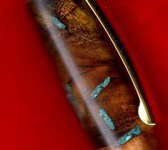Thanks for the FAST reply, Jim! Two more questions, if I may. Where do you get the turquoise? And do you usually fill when the blank is square, or turn it round before filling? Thanks again. Russ
If you want real gemstone inlays, there are plenty of places on the web where you can find all sorts of gemstones / minerals for sale. Buy what you want (beads or bags of chips), crush it to whatever texture you want and inlay just like Jim described.
Firemountain used to be a good place, but I haven't bought anything from them in a couple of years so it could be different now. Whatever you buy, make sure you don't buy dyed / stabilized or any other modifed gemstones. Only the real stuff will maintain it's color when crushed (and will be substantially more expensive).
If you get tempted by other great looking stones beyond turquoise, check the hardness before you buy. Some will be almost impossible to turn with normal lathe tools when inlayed.
I've always turned close to final shape / size before filling with expensive inlay material. You want to minimize the amount of expensive inlay material that ends up laying on the floor.
If you decide to fill when square and are doing very deep inlays, try filling in layers to insure the glue penetrates all the way.
Ed

